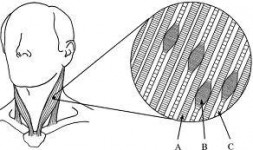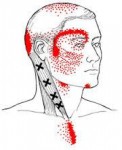Trigger points and massotherapy
Montreal masso-kinesitherapy
What is a trigger point ?
Trigger points are hyper-irritated points that can be found in any skeletal muscle in the body. These points can be palpated in tight muscle fibers and can radiate pain in a predictable pattern.
Because of this referred pain, it often happens that the source of pain suffered by patients is misdiagnosed or treated with little chance of success.
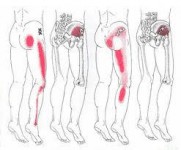
Ex: John comes to the clinic with abdominal pain that radiates down the side and back of the leg, sometimes around the knee and into the calf.
This pain pattern is related to sciatica and trigger points present in the gluteus medius muscle.
Trigger points can be active or latent. Active trigger points cause local and/or radiating pain, while latent trigger points are only painful when palpated and do not radiate. There is always a risk that latent trigger points will become active.
Do I have trigger points?
Generally, most people have trigger points, which, if not active, are latent.
Several factors can be responsible for the activation of these trigger points:
- Acute or chronic muscle overload
- Their activation by another trigger point
- A sickness
- A homeostatic imbalance
- Direct trauma to the area
- A traumatic accident (such as a car accident in which the muscles were overstretched)
Due to the many occupations that require sitting for eight hours a day, poor posture, inactivity, etc., muscle imbalances are becoming more common. This state of muscle imbalance provides an ideal environment for the formation and activation of trigger points.
How are trigger points treated ?
Direct ischemic pressure, combined with active and passive stretching techniques and local application of heat to encourage circulation, is an effective approach to treating trigger points.
It is very rare that I treat a patient without encountering at least a few trigger points. Although trigger point work can be painful at times, most patients describe it as “pain that feels good” or “good pain” and come back with a specific request to be treated with this technique again.
What should I expect when I receive treatment?
At Clinique Altermed, a typical trigger point treatment with my approach begins with an assessment of the patient. This allows me to identify problem areas and trigger points that may need to be worked on.
Once the assessment is complete, you sit on the treatment table, as you would for a massage. The treatment of trigger points can be done while remaining fully clothed; however, it is most effective when applied directly to the skin. I often combine deep tissue massage, myofascial release, hydrotherapy (heating wet compress) and offer stretching techniques to complement my trigger point work.
Once the treatment is complete, I show the stretches that can be done and how often they should be done to help prevent the trigger point from coming back.
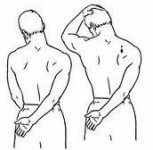
Treatment of a trigger point can, in some cases, cause muscle soreness (which is similar to what one may feel after physical training) that can last between 24 and 72 hours, and often requires several sessions to obtain the best results.
For more information, please contact Daniel Godin at Clinique Altermed.
Read articleMassage therapy and sports injuries
Montreal masso-kinesitherapy
What is a muscle ?
A muscle is a bundle of fibers that have the ability to contract and relax and allow movement.
There are 3 types of muscle in the body: skeletal muscle, smooth muscle, and cardiac muscle. One can consciously control skeletal muscles; however, smooth (mainly in organs) and cardiac (heart) muscles contract involuntarily.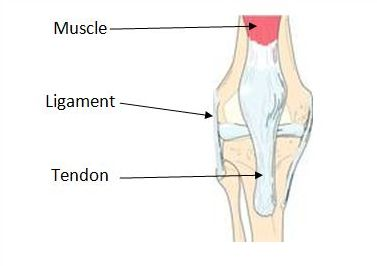
Muscles have tendons at their ends that attach them to bones (usually 2 separate bones). The contraction of the muscle allows the movements and the locomotion of the body.
What is a tendon?
A tendon is a bundle of fibrous connective tissues that generally serve to attach muscles to bones. Tendons work together with muscles to mobilize and move bones.
What is a ligament?
Ligaments, like tendons, are made of fibrous connective tissue. However, ligaments bind bones together to create joints.
Ligaments can limit movements and prevent others. Their main role is to stabilize the joints.
Sprain, strain and stretch (elongation): what's the difference?
A sprain is an injury that occurs to the ligaments when there is stretching of the muscles or tendons. The joint is then pulled beyond its normal range of motion and causes the ligament to stretch or tear. A strain is a stretching or tearing in the muscle or tendon that does not affect the ligament.
In both cases, the symptoms are similar and include: pain, inflammation and possibly the inability to move the affected joint.
A stretch (elongation) usually occurs where a muscle and a tendon attach together. This musculotendinous junction is prone to injury when a person is in action (eg running) and a muscle contracts involuntarily while stretched. Symptoms of a stretched muscle include: pain, muscle spasms, loss of strength and poor range of motion.
Severity of sprains and stretches
Sprains 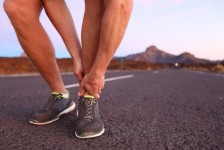 and stretches are classified according to their severity. A Grade I (mild) sprain or strain involves minimal stretching or tearing of a ligament or muscle. A grade II (moderate) sprain or strain is a ligament or muscle that is partially torn but remains intact. A Level III (severe) sprain or strain means that the ligament or muscle is completely torn, causing the joint to become unstable.
and stretches are classified according to their severity. A Grade I (mild) sprain or strain involves minimal stretching or tearing of a ligament or muscle. A grade II (moderate) sprain or strain is a ligament or muscle that is partially torn but remains intact. A Level III (severe) sprain or strain means that the ligament or muscle is completely torn, causing the joint to become unstable.
Treatment
When you are injured, observe the following instructions as soon as possible:
- Protect the injured area
- Rest the injured area
- Apply ice to the injured area for at least 20 minutes, 3 times a day.
- Compress the injured area to help prevent inflammation (don't overtighten though)
- Elevate the injured area above the heart to
prevent inflammation.
Level I injuries usually heal quickly, and a combination of proper exercise and stretching can help regain initial strength and flexibility.
Level II injuries are treated similarly but may require immobilization of the joint to allow proper healing.
Level III injuries are more severe and most often require immobilization and sometimes surgery to regain normal function.
In any case, it is important to be assessed by a health professional in order to define a treatment plan together. With the right approach, most people can heal their sprains and strains without long-term side effects.
Daniel Godin, Masso-kinesitherapist
Read article
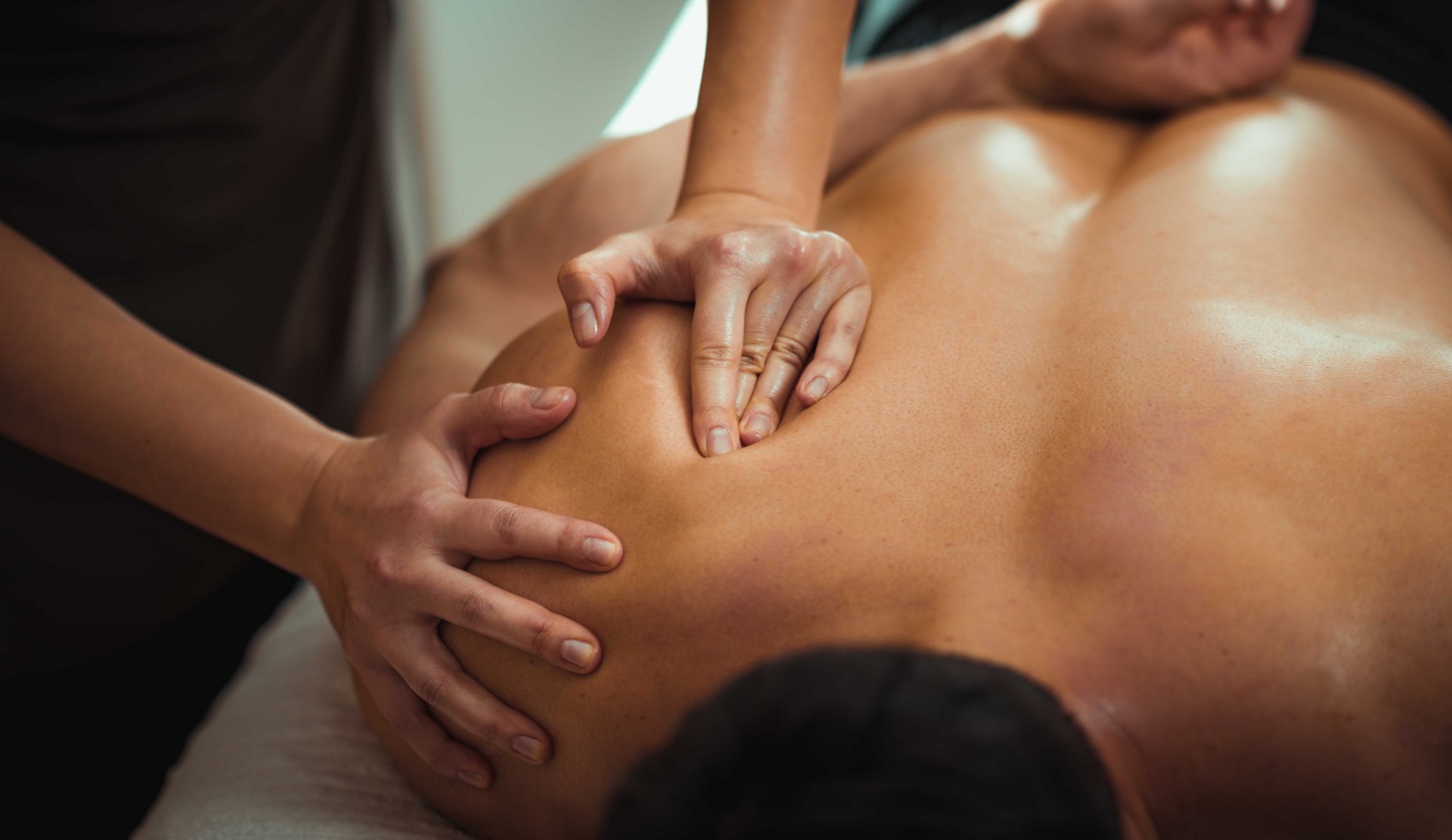
Sport Massage
Montreal masso-kinesitherapy
Sports massage at the Altermed Clinic is above all a therapeutic massage.
Its objectives are precise, and the depth and pace of the techniques allow for the evaluation and correction of body dysfunctions in real time.
It is a unique, pleasant and stimulating experience, based on :
the art of touch of the massage therapist
his/her precise biomechanical and physiological knowledge
his/her personal experience in the field of sports
his/her ability to evaluate the body's needs during the session
his/her precise advice as needed after treatment
The massage therapist takes into account the type of sport you practice, your level and the requirements related to it.
Why consult Sports Massage Therapy?
To increase the flexibility of the muscles
To increase the elasticity of the muscles
Eliminate muscular tensions that reduce the articular amplitude
Eliminate muscle cramps
Eliminate pain due to "muscle knots
Obtain or regain maximum joint range of motion in one or more joints
Reduce knee pain due to muscular tension overload
Relieve muscle pain related to periostitis
Relieve fatigue in the back due to repetitive impacts
Dissolve adhesions that appear following surgery or a deep laceration, which hinder your movements
When should I consult a sports massage therapist?
Throughout your training to help you keep your muscles healthy and keep your joint range of motion complete.
Throughout your training to prevent injuries due to muscle fatigue, tension or loss of mobility.
Before a sporting event to prepare your body to perform better.
During your sport activity to eliminate muscle tension, loss of amplitude and pain that may have occurred during your performance. This way, you will be in better condition for your next performance.
After your sporting event, either a few minutes after or the next day to help you recover more quickly from your efforts during your performance.
Following a sports injury, to accelerate your recovery time and reduce your convalescence time.
The benefits for the athlete
A better oxygenation of muscles and tissues
An increase in the supply of nutrients to the muscles
More efficient elimination of toxins stored in the muscles
An increased mobility
Better memorization of motor patterns
Prevention of injuries due to poorly extensible muscles
Improved recovery time following an injury
Better muscle preparation for an important sporting event
Elimination of the effects of stress on the body before and after a sporting event
Decrease in recovery time after a sporting event
Your massage therapist actively participates in your performance.
Your sports massage therapist must:
Listen to your expectations during your consultations
Know your health status
Know your injuries, surgery and medical problems
Evaluate your muscles and joints through mobility tests and palpation
Understand the movements and requirements of your sport
Understand your personal goals for your sport
Be aware of your training plan
Be aware of your competition schedules
Healthy muscles have the following qualities:
Good tone
Excellent elasticity (ability to return to their original length after stretching)
and flexibility (ability to stretch without tearing or rupturing tendons)
These three components are essential to avoid injuries such as tendonitis, periostitis, strains and sprains. A good pre-workout warm-up and post-workout stretching program will keep your muscles healthy. Regular massage therapy sessions will help maintain these muscular qualities.
Healthy muscles are also :
well oxygenated
well nourished
with an efficient elimination of organic waste
and adequate hydration
To achieve this, it is important to develop a good cardiovascular system, good eating habits and continuous hydration. When one of these elements is deficient, muscular tensions appear and can transform into contractures (muscular knots). These often lead to pain and loss of mobility.
When this happens, your massage therapist is able to eliminate your contractures. In massage therapy, we work with blood circulation, promoting oxygenation, nutrient intake and the elimination of organic waste accumulated in your muscles.
Who can benefit from sports massage?
Sports massage is ideal for regular athletes; whether you are a man, a woman or a child, you can benefit from this type of massage.
Read article


